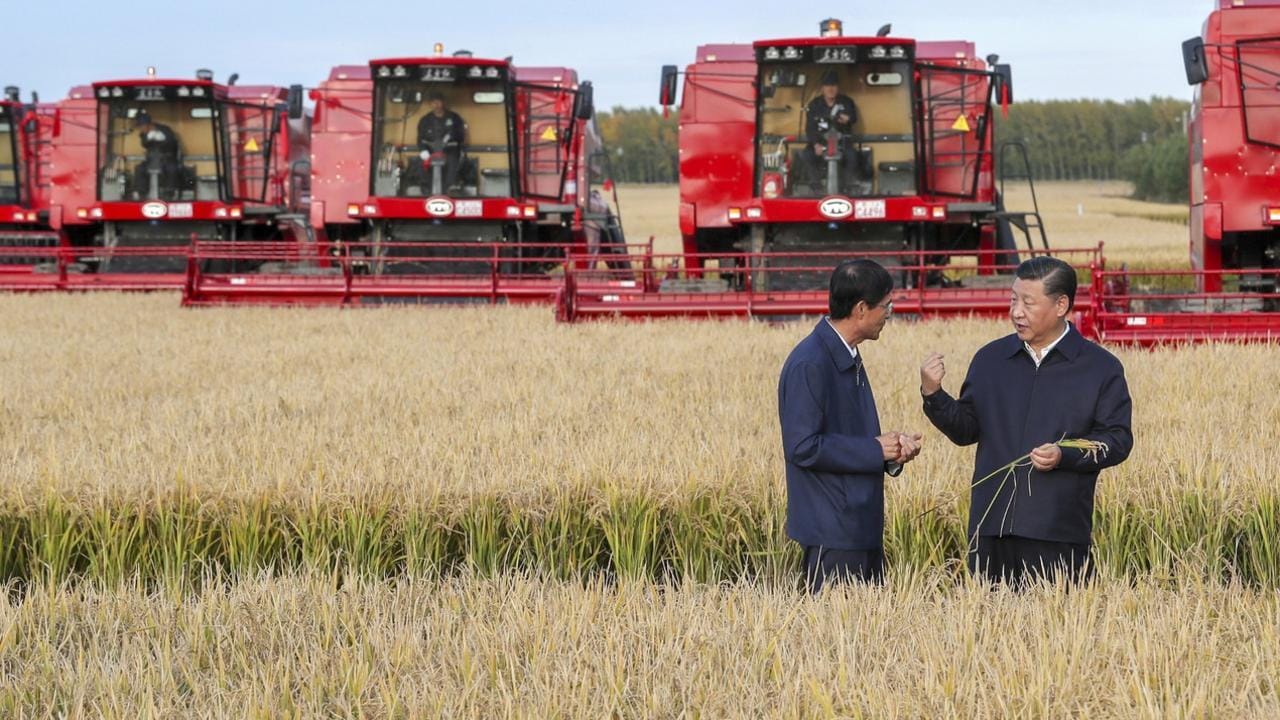- The Daily Yield
- Posts
- 🤖 Barn-to-bytes
🤖 Barn-to-bytes
Old MacDonald's farm looking like a Silicon Valley startup.
🤙 Happy Monday! Tractors drive themselves, drones scout fields, and retrofitted gear keeps old machines running like new. At this rate, the only thing missing is a farm-themed startup called 'AgriFy' pitching investors on sustainable, blockchain-powered corn.
— TDY team
AG-TECH & INNOVATION

🧬 Plants and microbes the ultimate soil bromance: Scientists at the John Innes Centre have uncovered a secret that plants have been wooing soil microbes all along. This discovery could mean farmers might soon say goodbye to their fertilizer habit.
Researchers, led by Dr. Myriam Charpentier, stumbled upon a gene mutation in the legume Medicago truncatula that turns plant roots into microbial magnets. This mutation enhances the plant's ability to form cozy relationships with nitrogen-fixing bacteria and phosphorus-supplying fungi.
The result? Plants get their nutrient fix straight from the soil's natural pantry, cutting down on the need for artificial fertilizers.
But legumes aren't the only ones having all the fun.
The team found that introducing this mutation into wheat also boosted its microbial mingling skills (in real-world conditions). This opens the door to developing non-GM wheat varieties that buddy up with soil microbes for their nutrient needs.
Why Should Farmers Care?
For farmers, this plant-microbe matchmaking is a game-changer:
Fewer Fertilizers: With crops tapping into the soil's own nutrient network, farmers can lighten their fertilizer load, saving money and reducing environmental impact.
Healthier Soils: Encouraging these natural partnerships can improve soil structure and fertility over time.
Sustainable Farming: Less reliance on chemical inputs aligns with eco-friendly practices, appealing to environmentally conscious consumers.
In short, by playing Cupid between plants and microbes, scientists are helping farmers cultivate crops that are both high-yielding and low-maintenance. It's a win-win for agriculture and Mother Nature.
FARMING TRENDS

🧑💻 Gadgets, gizmos, and grain carts: As 2025 rolls in, farmers are swapping their overalls for tech gear, embracing innovations that make Old MacDonald's farm look like a Silicon Valley startup. The agricultural industry is seeing a shift in how equipment is used, retrofitted, and even how fleets are managed, with farmers now taking a more customized, mix-and-match approach.
Gone are the days of sticking to one brand. Farmers are assembling mixed fleets, choosing the best machinery for each task rather than committing to a single manufacturer. Why?
Optimizing performance
Not locked into a single ecosystem
Better deals with higher competition for for their business
Farmers are keen to avoid being "captive" to a single brand, and it’s forcing equipment suppliers to stay competitive.
While some are investing in new tech, others are turning to retrofit kits to bring their old machines into the future. Companies like OutRun.Ag and New Holland are rolling out kits that can turn a traditional grain cart into an autonomous machine, eliminating the need for an extra driver.
Think of it like slapping a Tesla autopilot system onto your grandpa’s old farm truck, except this one won’t end up in a ditch. 🥲
Drones are also taking center stage, particularly in spraying applications. With the ability to cover fields quickly and precisely, spray drones are gaining traction as a cost-effective and efficient alternative to traditional ground-based sprayers.
They require no coffee breaks
Don’t complain about long hours
Won’t leave tire tracks in a wet field
What’s not to love?
Although they may not be a complete replacement for large acre spraying needs, they are proving themselves to be incredibly effective for targeted spraying and crop monitoring.
Additionally, self-driving tractors and robotic harvesters are becoming a practical solution for labor shortages, giving farmers one less headache to deal with. John Deere and other manufacturers are rolling out machines that can work fields with minimal human input, making it easier to manage large-scale operations.
*Why do I need autonomy?*
Would an extra worker come in handy? One that's never late. One that won't mind working all night.
Would you like to cheat time?
By leaving the tractor out to do more work, you can shave precious minutes off tight windows, beat the weather and take advantage of favorable soil conditions when the time's right.
That's more acres and more productivity, all without adding more labor.
The result? More efficient operations, lower costs, and maybe, just maybe, a little more time to breathe during harvest season.
AG BITES

😷 USDA Secretary Addresses Avian Flu in Texas: U.S. Secretary of Agriculture Brooke Rollins is set to visit Texas to discuss the ongoing avian flu outbreak. The roundtable aims to strategize on containment and prevention measures.
🇨🇳 China's Push for Agricultural Innovation: China's latest policy blueprint emphasizes developing new productive forces in agriculture, including accelerating key technological breakthroughs and fostering leading enterprises in agricultural science and technology. The plan aims to strengthen agricultural innovation and expand the use of artificial intelligence in farming.
💩 EU Turns to Manure Amid Fertilizer Shortage: In response to reduced Russian fertilizer imports, the European Union is promoting the use of domestically produced manure-based fertilizers.
📚 Revitalizing Agriculture Education in Michigan: Unionville-Sebewaing Area schools have expanded their Future Farmers of America program (FFA). The initiative fosters agricultural literacy and community involvement.
COMMODITY REPORT
📊 Oil trips while natural gas flexes: Last week, the commodity futures market swung around like a barn door in a windstorm, thanks to the ongoing political drama, unpredictable weather, and economic policies that may or may not make sense. Here’s how the key commodities stacked up.
Energy Commodities: Crude oil (WTI) closed at $70.40 per barrel, a decrease of $2.08 (2.87%) from the previous session. This decline marks the fifth consecutive weekly loss, attributed to rising oil supplies and demand concerns. Brent Crude: Settled at $74.43 per barrel, down $2.05 (2.68%). The market faced pressure from increased U.S. crude inventories and uncertainties surrounding President Trump's policy decisions, including potential tariffs and requests for increased oil production from OPEC. Natural Gas: Experienced a significant surge, closing at $3.50 per million BTUs, up 13.66% for the week. The spike was driven by an Arctic blast leading to increased heating demand and production challenges due to freeze-offs.
Metals: Gold prices declined as investors take profits from previous highs. The market reacted to mixed economic signals, including potential interest rate cuts by the Federal Reserve amid cooling inflation. Iron ore futures reached a four-month high, with the most-traded May contract on China's Dalian Commodity Exchange rising to 838.5 yuan ($115.75) per metric ton. This increase is driven by expectations of higher steel consumption in China and anticipated economic stimulus measures.
Agricultural Commodities: Corn March futures closed at $4.98 per bushel, reflecting stability amid favorable weather conditions and strong export demand. Soybeans March futures settled at $10.35¼ per bushel, experiencing minor fluctuations due to global supply considerations and trade dynamics. Wheat March futures fell to $5.97¼ per bushel, influenced by favorable growing conditions in key production areas, including France, where crop ratings have improved. Canola $667.80 per metric ton. Prices hovered near six-month highs, influenced by tightening global oilseed supply and robust demand.
🔎 Market influences: A combination of political tensions, particularly surrounding U.S. policy shifts and ongoing discussions related to the Ukraine conflict. Weather events, such as the Arctic blast affecting energy demand and production, also played a critical role. Investors are advised to monitor these developments closely, as they are likely to continue influencing commodity prices in the near term.
Prices were provided by: Yahoo! Finance
Disclaimer: Commodity and market information contained herein is believed to be accurate but is not guaranteed. The Daily Yield and information sources assume no responsibility or liability for any action taken as a result of any information or advice contained in these reports, and any action taken is solely at the liability and responsibility of the user.
SPREAD THE YIELD
🔥 Don’t keep the good stuff to yourself! Share this newsletter with fellow farmers, students, ag insiders, investors, and anyone who loves staying ahead of the curve.
The more we grow, the better we get, just like a well-fertilized crop! 📈
BRAIN AG-TIVATOR
🤔 Ag Riddle of the Day
I work hard but never sweat,
I feed the world but never eat.
I lose weight as I do my job,
Yet without me, the harvest is incomplete.
What am I?
Gratitude makes sense of our past, brings peace for today, and creates a vision for tomorrow.
Answer: A Millstone! 🪨
(A millstone grinds grain into flour, working tirelessly without "sweating." It gradually wears down (loses weight) over time, but without it, there’s no flour for bread, the staple of many diets!)
Reply